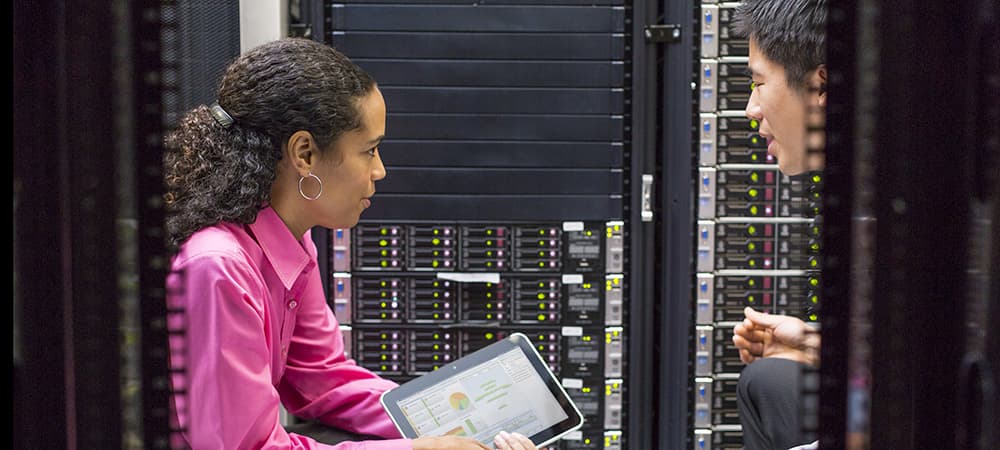Servers play an increasingly important role in small business infrastructure and keeping sensitive data safe, and the growth of the server market reflects this. The global server market
surpassed $91 billion in 2020. That number is expected to increase every year as data needs continue to grow.
How can your company harness the power of a server? What does it take to employ one in your own company? Learning how to set up a business server is an important first step to take before you make any major purchasing decisions.
What is a server?
A server is a physical device or a computer program that provides other computers on the same network access to information, programs, services, or storage space. The other computers on the network are called "clients," and the goal of the server is to offset some of the burdens from these clients.
Servers help prioritize resources and may also provide a safer framework for sharing and storing data than individual computers. They may be named based on their job, such as a “file server for small business,” for example, if it exists solely to serve client files.
You can use servers to host and serve many business functions, including:
- Business apps
- Data storage and backup
- Databases
- Ecommerce
- Email
- Files
- Websites
Many small office servers are considered “dedicated servers” because they are devoted to one function. Your email server, for example, exists to receive, store, and serve email data. Another example is an ecommerce server, which hosts and serves your business’s online store.
Small business server options
In addition to having different functions, servers fall into types or categories. By familiarizing yourself with these options, you can have a preference in mind before choosing one and moving forward with a purchase.
1. Cloud solutions vs onsite servers
Many of us already use cloud-based servers for the things we do as consumers. The concept is the same when talking about data storage solutions for small business needs. Storing your work files on a Google Drive, for example, takes advantage of the robust cloud servers offered by Google. And if you choose to store those same files on a physical server at your own location, you would use an “onsite” server.
Note that all cloud services are simply the same type of onsite physical servers you would use at your own business. They may be larger or more powerful, but there isn’t anything magical about the cloud. It’s simply a way of saying that the server doing all of the work isn’t physically located at your business and that someone else does the maintenance.
Not sure about choosing server vs. cloud for small business? Hybrid options exist for those who want the best of both worlds.
2. Windows vs Linux
Just as you would choose an operating system for your computer, you need an operating system for a shared server for small business. There are benefits to choosing Windows if you’re comfortable with Windows-based technology but Linux has its own perks. Explore the benefits of each to get a feel for what’s right for you and your IT team.
You may choose a small business server configuration based on the talent you can find to keep everything running smoothly. Windows and Linux aren’t the only technologies available, either, but they’re the most notable.
Planning and purchasing server components
If you feel ready to buy a server system for your small business, you’ve likely already decided on a technology and picked an onsite server. What’s next? You have some tough questions to answer, but going through the exercise of the next steps is crucial to avoiding buyer’s remorse.
1. Know your budget
What you can pay and what you should pay are two very different numbers, and you may find that you can’t afford the best storage server for small business on the market. That’s exactly why it’s crucial to have your maximum budget amount in mind. You can work from there to figure out if renting hardware instead of buying, or using a cloud-based option for some of your data will get you what you need for what you can afford.
Servers can run under $100 per month to rent and over $2,000 to buy. This is for an individual server, however, and doesn’t include the server room cost, maintenance, security, and staff to run and protect your servers. Since this is a significant investment, you should be prepared to share your ROI with stakeholders who may ask, "Why invest so much?"
You should also expect your budget to change over time. Services cost more year after year, and the parts used to build servers change, too, so factor those costs into your budget.
2. Know the tasks you’ll run
You are likely to receive some additional direction from the seller of the server you decide to buy, but prepare for the discussion by putting together a list of jobs you’ll need the server to do. This can help you stay within your budget.
To get an idea of the hard drive, processor, and RAM your server must have, ask yourself these questions:
- What applications will we run from the server?
- How many people will use each application at a time?
- How will our business grow?
- Will the number of people using an application or the number of applications we use grow significantly over the next few years?
3. Decide on the components
Before you get started, you’ll need all the parts. These will vary by how you plan to use the server. You will need a hard drive with enough space and speed to handle your work, as well as the right amount of RAM.
How can you know the parts you pick will be up to the tasks? You can estimate some resource needs in advance with these steps.
- Take the list of applications you put together in Step 2 and do further research on each application. You can find some calculators from various server businesses that will help you understand the resources necessary to run various programs at the capacity of your business.
- Record the results and note the high and low estimates of what you’ll need for each program or application. Add them together to get the average capacity for when you server shop, then add 20% for peak usage spikes.
- Now you have the minimum spec requirements for most parts – start there. You may want to work with a third-party expert to go over other needs, such as RAID, hot-swappable drive bays, CPU, power supply options, and hardware redundancy. An outside consultant may also bring new concerns to light that you didn’t consider, such as whether you need a newly designed internet connection infrastructure.
- Go over the specs for your server room in advance, including any windows, backup power, and cooling systems that will keep your equipment safe. This step alone can be a burden for businesses, but it’s one you must do before you shop for your equipment.
- Ask your IT team questions to help them in planning your server room setup. How will you meet needs through racks, cable management, and security? Again, get outside help if you feel overwhelmed.
How to find a reputable business
Discovering the right server company may feel difficult at first. Start your search by asking business colleagues and others who are happy with their server solutions where they went. A referral is worth a lot in this business.
Look for red flags when speaking to a potential server sales rep. They should listen to your unique needs and be able to answer all of your questions regarding your individual tech preferences. Avoid companies that offer a one-size-fits-all approach or insist on setting you up with the same server system as a company much larger or much smaller than your business.
If they aren’t willing or able to bump up their small business file server solutions, for example, or they avoid giving you real-life examples of their servers in the business world, look elsewhere. Reputable businesses will want to provide case studies or contact information of happy customers who are willing to share their positive experiences with you.
Next steps
Setting up a small business server is a considerable investment. Whether you buy for onsite solutions or take your business to the cloud, use the same level of care and research before making any purchases. Your existing tech supplier may even have leads on
where to get the best price and experience on a server.
If you buy all of your equipment from one company, start there to see what they recommend for taking your business to the next level. A tech rep should be able to do a complete needs analysis and get you on the right path toward the server you’ve always wanted.
About the Author: Linsey Knerl is a contributing writer for HP Tech@Work. Linsey is a Midwest-based author, public speaker, and member of the ASJA. She has a passion for helping consumers and small business owners do more with their resources via the latest tech solutions. Popular HP business solutions
















